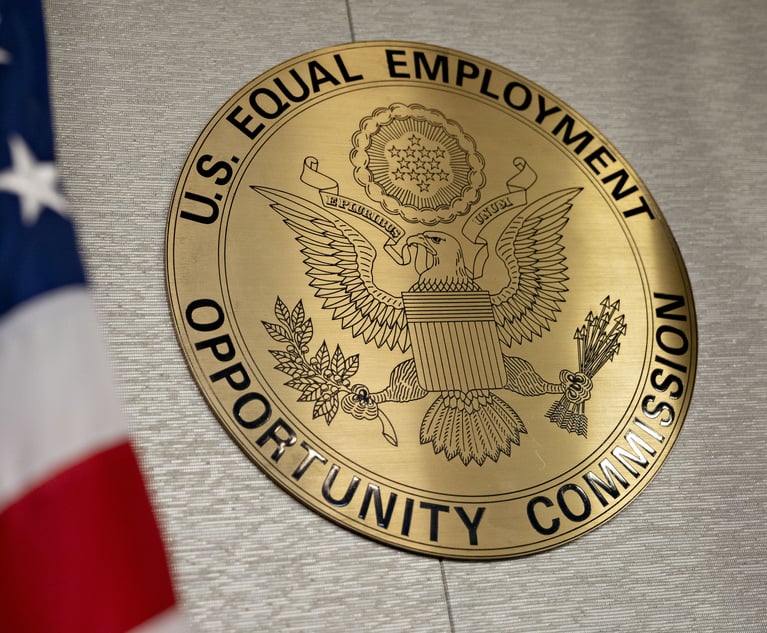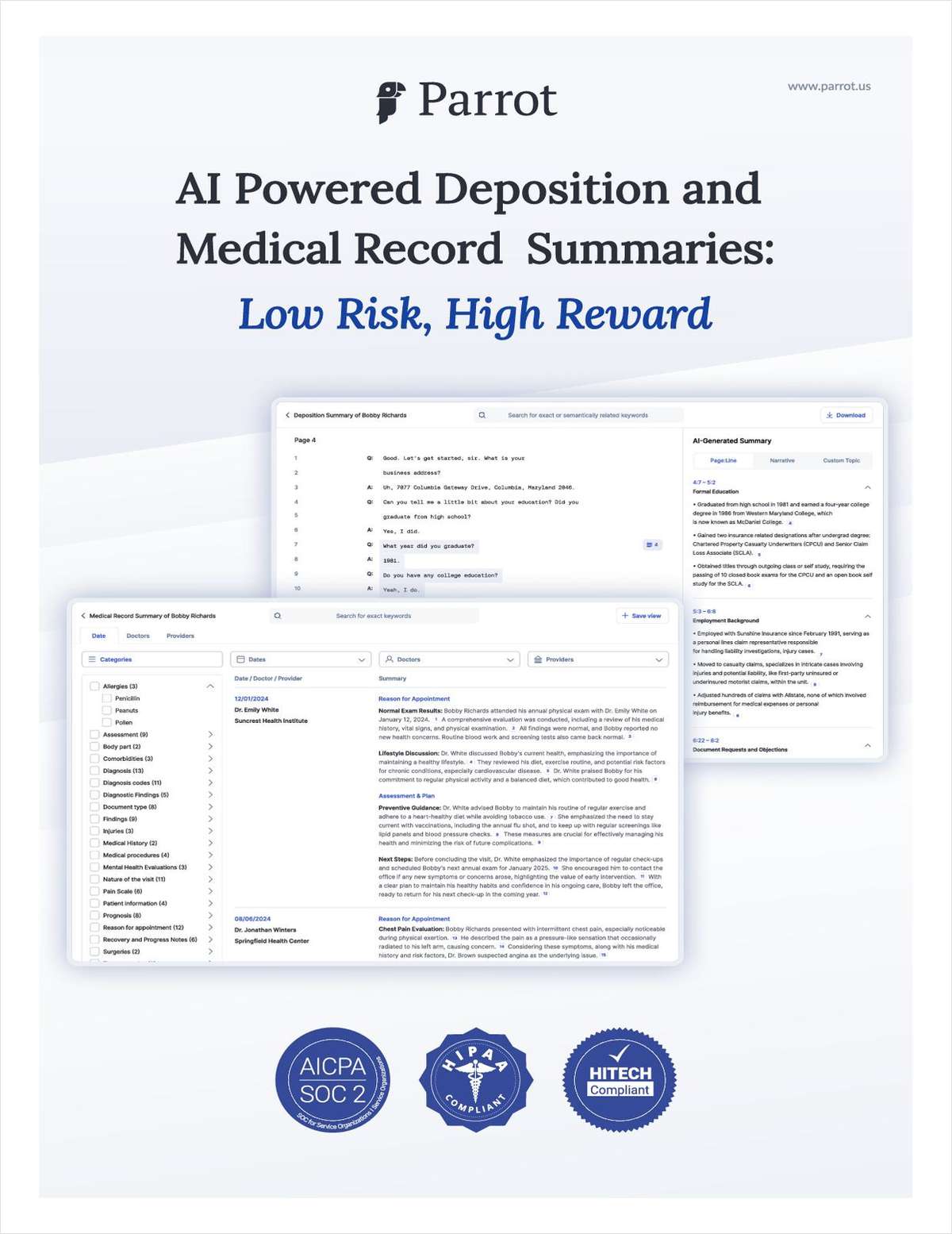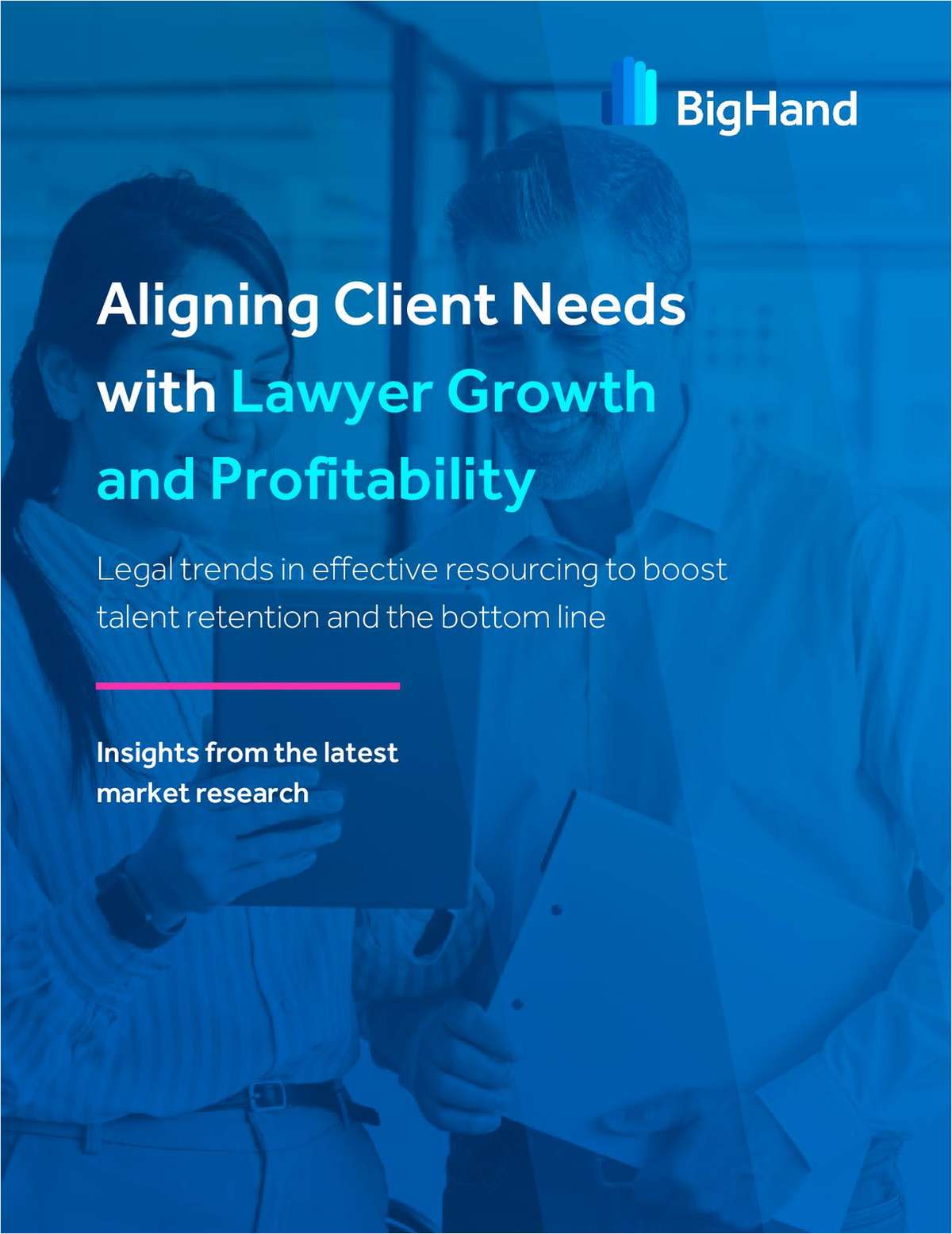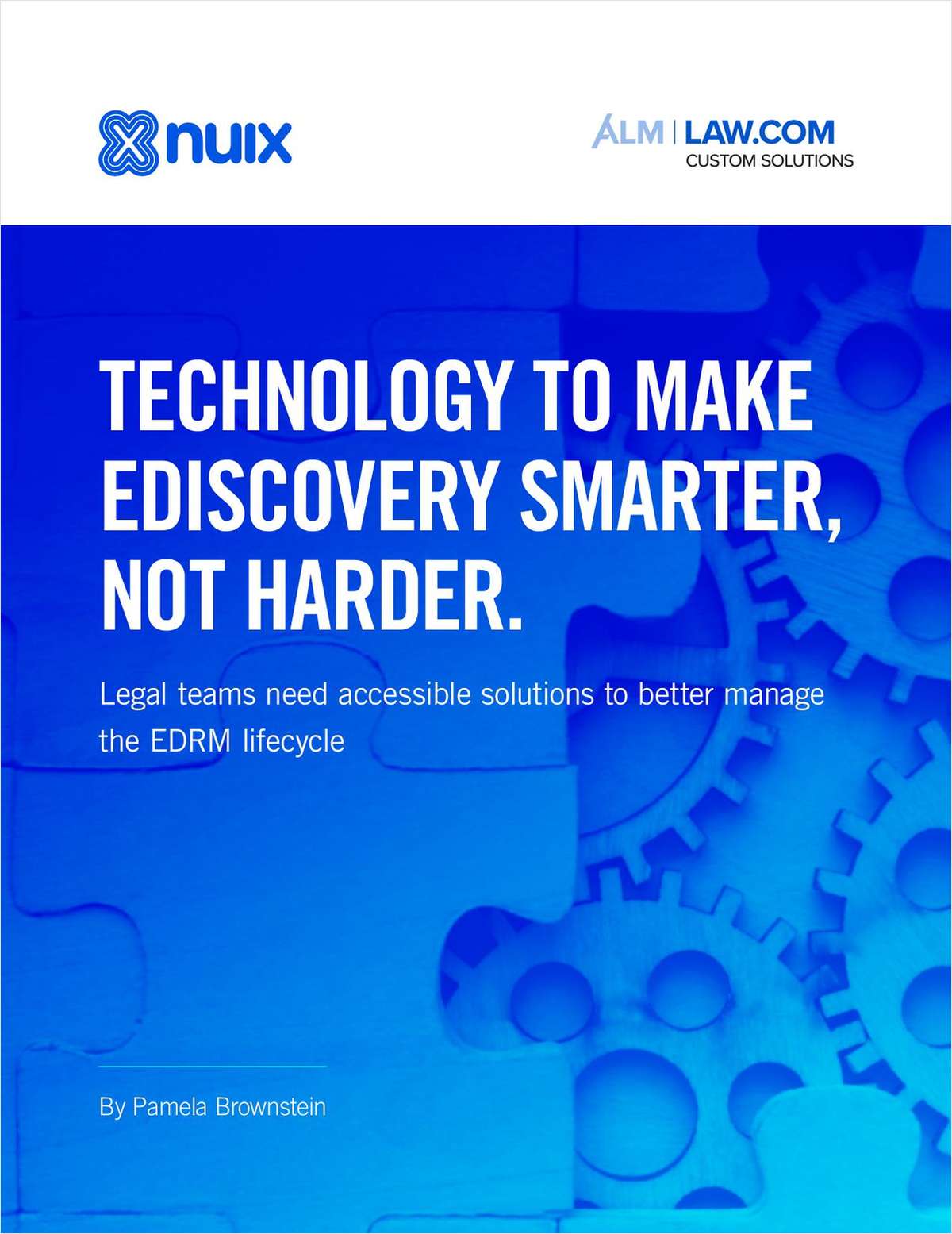How Law Firms Are Overcoming New Business Development Challenges
With the intense competition for new legal work, demands on lawyers' available time and the increasing discounts clients demand, it's getting harder for law firms operating under a billable-hour business model to support the consistent development of new legal work by investing in and maintaining a marketing department alone.
January 08, 2020 at 05:04 PM
9 minute read
This article appeared in Marketing the Law Firm, an ALM/Law Journal Newsletters publication reporting on the latest, and most effective, strategies for Chief Marketing Officers, Managing Partners, Law Firm Marketing Directors, Administrators and Consultants.
With the intense competition for new legal work, demands on lawyers' available time and the increasing discounts clients demand, it's getting harder for law firms operating under a billable-hour business model to support the consistent development of new legal work by investing in and maintaining a marketing department alone.
Lack of Time Is a Lawyer's Greatest Challenge
The vast majority of a lawyer's total available professional time is spent producing and delivering legal work to clients. All law firms' revenues are generated by firm lawyers and professionals producing, delivering, billing for and collecting on the legal work they do for clients. So most lawyers spend 80%-100% of their time fueling the lifeblood of the firm by generating billable hours and revenues. Due to these realities, once lawyers are done with their legal work and associated tasks, most are either exhausted or have numerous other professional and personal demands on their remaining available time.
In addition, most lawyers:
- Focus their very limited available business development time on speaking, presenting, attending conferences and writing. Each of these traditional marketing activities increases visibility and may develop business, but not as productively as other means. The fact is, almost all new legal work is awarded either during or shortly after a private, one-on-one or small group meeting or conversation, yet most lawyers don't have the time, inclination or skill to plan, conduct and follow up on qualified leads.
- Only make time and effort to market or develop business when they are less than fully busy, e., often when a case or matter ends. But because the sales cycle for outside legal services can be long and usually requires many appropriate contacts over time, many lawyers find it difficult to follow up and stay in touch over the two or more years it often takes to convert qualified leads into actual new legal work.
- Know their own practice and practice group, but not the whole firms.
- Do not have time to create, use or maintain a regular client development action plan. Instead, they engage in client or business development only when they are not busy (which, for most successful lawyers, is not very often).
Defining and Measuring Qualified Leads
A qualified lead is defined as one in which an existing client, prospective client or referral source communicates an interest in a legal area or topic. Most often, qualified leads come in the form of questions a client or prospective client asks, such as, "Does your firm have a written cybersecurity policy it recommends?" "Does your firm do FCPA work?" "Are any of your partners experienced in oil and gas?" Clients or prospects ask these kinds of questions because they have (or someone they know has) a need for outside counsel, advice or representation.
Once a need is identified, it needs to be qualified, which consists of an internal review or assessment of the lead, which answers these (and other) questions in the affirmative: "Are there any conflicts?" "Is this the type of client our firm wants?" "Is this the type of legal work our firm wants and does well?" Then, the only way any qualified lead is converted into new legal work for the firm is if someone in the firm communicates directly with the person(s) who expressed the need. A firm lawyer (or other firm representative) needs to get in touch, stay in touch, respond appropriately and in a timely manner, follow up and follow through to develop the lead and relationship into new work or a new client. Lead qualification and relationship development are jobs and responsibilities that, in the past, have been traditionally handled by firm lawyers, but this is changing due to the time, effort, skill and discipline these processes take.
Formalizing New Business Plans Into Pipelines
Increasingly, law firm leaders embrace the fact that having an ongoing and robust pipeline of organic new business opportunities and qualified leads is critical to the continued success of their firms (in addition to regularly identifying and acquiring new laterals).
To help ensure a robust pipeline of new business opportunities, most law firms have established dedicated in-house marketing and business-development departments tasked with generating opportunities and qualified leads for new business by planning and implementing common marketing efforts, such as websites, blogs, seminars, events, publicity, speaking opportunities and other marketing tools. But the challenge of converting qualified leads generated by marketing efforts into actual new clients and legal work remains significant, often due to lawyers' lack of engagement or available time.
In recent years, more law firms are requiring each individual lawyer or practice group/department to create a written annual business plan, which often includes lists of client development targets and marketing activities. More firms are using the responses to the required annual plans to create a formal pipeline of qualified leads that can be and are tallied, tracked, followed up on and reported to firm leadership. Yet, challenges regarding these required annual plans remain significant, because in many law firms, the annual plans are not tallied, tracked or followed up on in any meaningful manner. In fact, in many firms, the only time the annual plan is reviewed or revisited is once a year, usually at year-end, around compensation or annual review time.
Hiring CREs and Requiring KPIs
To provide staff support within the firm to help overcome the challenges described above, more law firms are creating positions and hiring qualified, full-time, in-house Client Relationship Executives (CREs) with titles such as client executive, client development executive, director of client services or relations, chief client officer, chief growth officer, account manager and relationship manager.
These CRE positions are most often filled by nonpracticing lawyers, those with significant in-house counsel contacts or those with significant contacts within a specific industry. These positions mimic and are adapted from the sales support model used in many major accounting and other professional services firms. Which law firms now have these CRE positions in operation? Baker Donelson, Ballard Spahr, Cooley, DLA Piper, Goulston & Storrs, Mintz, Morgan Lewis, Orrick, Ropes & Gray, Womble Bond Dickinson and others.
Regardless of the title of the CRE, the common denominator of all these CRE-type positions is that they are filled with experienced, client-facing sales professionals whose responsibilities at the firm can include: generating qualified leads; strategic account management; developing select existing, new and qualified relationships; converting qualified leads into new legal work for the firm or for a specific practice area/group; assisting with or handling all follow-up; providing appropriate sales coaching to the lawyers to bring in the work; and reporting results to firm leadership. Law firms that have CREs make them responsible for qualified lead generation and accompanying pipeline creation, management, coaching, tracking and results reporting.
The quarterly reports of the CREs often include Key Performance Indicators (KPIs) categorized and defined by both lead type and by the value the CRE contributed. For example, leads are often distinguished as:
- Marketing qualified leads (MQLs): Qualified leads from a person/client/attendee whom had contact with the firm's marketing efforts, such as articles, publications, a seminar, events, alerts, etc.; or
- Sales qualified lead (SQL): A personal, one-to-one contact or relationship with an individual who works in a target company or with an individual who has legal needs the firm could be serving.
Both MQLs and SQLs can be and are often tracked in levels, such as:
- Level 1 lead: There was no significant prior firm relationship or the relationship was old/stale, but if not for the CRE's contacts, work and effort, the new work or client would not have come to the firm.
- Level 2 lead: There was an existing lead (such as a firm lawyer already had a relationship, noted it as a target prospective client or referral source on their annual plan, met someone new at a conference, received an unexpected RFP) that the CRE (upon request by a firm lawyer) assisted in bringing the work or new client into the firm. The CRE's assistance and contributions can be measured by relevant firm lawyers using a scale of 1-10, with 10 being the most significant, or as: 1) highly significant; 2) helpful; or 3) not significant.
- Level 3 lead: New opportunities arise when the CRE is asked to assist in various ways. Like Level 2 leads, the CRE's assistance and contributions with Level 3 leads can also be measured by relevant firm lawyers.
Many law firms using CREs to work on overcoming common business development challenges are finding success, with most CREs paying for themselves within a year to a year-and-a-half of being hired.
All law firms face similar challenges to new business development, especially since all firms only have a limited budget and amount of time to invest. But to consistently generate and effectively support a stream of new business within any firm requires appropriate investments in people, process and technologies, the balance of which varies from firm to firm depending on culture, desires of key partners, strategic plans and other factors.
*****
Related Resources
- "Building a Professional Sales Team within Your Law Firm," By Silvia Coulter, Thomson Reuters
- "Serving up Strategy? Save Law Firm Sales Pros a Seat at the Table," By Beth Cuzzone and John Hellerman, Attorney At Work
- "From Client Teams to Strategic Account Management: The Next Wave in Law Firm Sales," By Silvia Coulter and Yvonne Nath, JD Supra
- "It's Time for Account Management in Law Firms," By Kate White, Thomson Reuters
*****
Julie Savarino holds an MBA, a JD, and is a licensed attorney. Over her 30+ year career, she has built a reputation as a leading international, award-winning business and client development and service strategist and coach for lawyers, law firms, and other professional services providers and firms. She has successfully served in-house in client and business development positions for the law firms of Dickinson Wright and Butzel Long and for the accounting firm Grant Thornton. Connect with Julie on LinkedIn at juliesavarino and Twitter @JulieSavarino, or contact her at [email protected].
This content has been archived. It is available through our partners, LexisNexis® and Bloomberg Law.
To view this content, please continue to their sites.
Not a Lexis Subscriber?
Subscribe Now
Not a Bloomberg Law Subscriber?
Subscribe Now
NOT FOR REPRINT
© 2025 ALM Global, LLC, All Rights Reserved. Request academic re-use from www.copyright.com. All other uses, submit a request to [email protected]. For more information visit Asset & Logo Licensing.
You Might Like
View All

Trump Administration Faces Legal Challenge Over EO Impacting Federal Workers
3 minute read
Elon Musk’s Tesla Pay Case Stokes Chatter Between Lawyers and Clients
7 minute readLaw Firms Mentioned
Trending Stories
Who Got The Work
J. Brugh Lower of Gibbons has entered an appearance for industrial equipment supplier Devco Corporation in a pending trademark infringement lawsuit. The suit, accusing the defendant of selling knock-off Graco products, was filed Dec. 18 in New Jersey District Court by Rivkin Radler on behalf of Graco Inc. and Graco Minnesota. The case, assigned to U.S. District Judge Zahid N. Quraishi, is 3:24-cv-11294, Graco Inc. et al v. Devco Corporation.
Who Got The Work
Rebecca Maller-Stein and Kent A. Yalowitz of Arnold & Porter Kaye Scholer have entered their appearances for Hanaco Venture Capital and its executives, Lior Prosor and David Frankel, in a pending securities lawsuit. The action, filed on Dec. 24 in New York Southern District Court by Zell, Aron & Co. on behalf of Goldeneye Advisors, accuses the defendants of negligently and fraudulently managing the plaintiff's $1 million investment. The case, assigned to U.S. District Judge Vernon S. Broderick, is 1:24-cv-09918, Goldeneye Advisors, LLC v. Hanaco Venture Capital, Ltd. et al.
Who Got The Work
Attorneys from A&O Shearman has stepped in as defense counsel for Toronto-Dominion Bank and other defendants in a pending securities class action. The suit, filed Dec. 11 in New York Southern District Court by Bleichmar Fonti & Auld, accuses the defendants of concealing the bank's 'pervasive' deficiencies in regards to its compliance with the Bank Secrecy Act and the quality of its anti-money laundering controls. The case, assigned to U.S. District Judge Arun Subramanian, is 1:24-cv-09445, Gonzalez v. The Toronto-Dominion Bank et al.
Who Got The Work
Crown Castle International, a Pennsylvania company providing shared communications infrastructure, has turned to Luke D. Wolf of Gordon Rees Scully Mansukhani to fend off a pending breach-of-contract lawsuit. The court action, filed Nov. 25 in Michigan Eastern District Court by Hooper Hathaway PC on behalf of The Town Residences LLC, accuses Crown Castle of failing to transfer approximately $30,000 in utility payments from T-Mobile in breach of a roof-top lease and assignment agreement. The case, assigned to U.S. District Judge Susan K. Declercq, is 2:24-cv-13131, The Town Residences LLC v. T-Mobile US, Inc. et al.
Who Got The Work
Wilfred P. Coronato and Daniel M. Schwartz of McCarter & English have stepped in as defense counsel to Electrolux Home Products Inc. in a pending product liability lawsuit. The court action, filed Nov. 26 in New York Eastern District Court by Poulos Lopiccolo PC and Nagel Rice LLP on behalf of David Stern, alleges that the defendant's refrigerators’ drawers and shelving repeatedly break and fall apart within months after purchase. The case, assigned to U.S. District Judge Joan M. Azrack, is 2:24-cv-08204, Stern v. Electrolux Home Products, Inc.
Featured Firms
Law Offices of Gary Martin Hays & Associates, P.C.
(470) 294-1674
Law Offices of Mark E. Salomone
(857) 444-6468
Smith & Hassler
(713) 739-1250









